![]() How many suffer health harms caused by frac’ing? Is anyone looking at cumulative frac pollution in Canada, what are the costs to society? How many deaths annually?
How many suffer health harms caused by frac’ing? Is anyone looking at cumulative frac pollution in Canada, what are the costs to society? How many deaths annually?![]()
The trillion dollar question: what does a trillion look like?
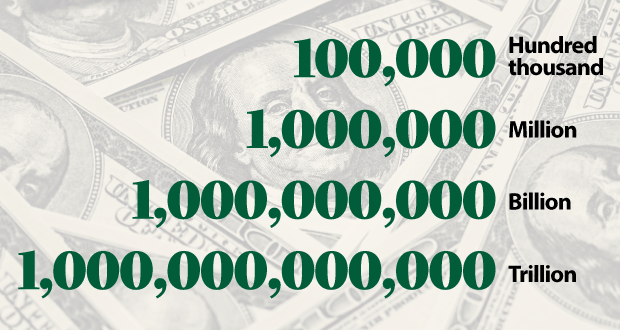
The study: Global mortality from outdoor fine particle pollution generated by fossil fuel combustion: Results from GEOS-Chem by Karn Vohra, Alina Vodonos, Joel Schwartz, Eloise A. Marais, Melissa P. Sulprizio, Loretta J. Mickley
Deaths from fossil fuel emissions higher than previously thought, Fossil fuel air pollution responsible for more than 8 million people worldwide in 2018 by Leah Burrows Press contact February 9, 2021, Harvard John A. Paulson School of Engineering and Applied Sciences
More than 8 million people died in 2018 from fossil fuel pollution, significantly higher than previous research suggested, according to new research from Harvard University, in collaboration with the University of Birmingham, the University of Leicester and University College London. Researchers estimated that exposure to particulate matter from fossil fuel emissions accounted for 18 percent of total global deaths in 2018 — a little less than 1 out of 5.
Regions with the highest concentrations of fossil fuel-related air pollution — including Eastern North America, Europe, and South-East Asia — have the highest rates of mortality, according to the study published in the journal Environmental Research.
The study greatly increases estimates of the numbers killed by air pollution. The most recent Global Burden of Disease Study, the largest and most comprehensive study on the causes of global mortality, put the total number of global deaths from all outdoor airborne particulate matter — including dust and smoke from wildfires and agricultural burns — at 4.2 million.
The findings underscore the detrimental impact of fossil fuels on global health.
How did the researchers arrive at such a high number of fossil-fuel-caused deaths?
Our study adds to the mounting evidence that air pollution from ongoing dependence on fossil fuels is detrimental to global health. We can’t in good conscience continue to rely on fossil fuels, when we know that there are such severe effects on health and viable, cleaner alternatives. Eloise Marais Associate Professor, University College London
Previous research relied on satellite and surface observations to estimate the average global annual concentrations of airborne particulate matter, known as PM2.5. The problem is, satellite and surface observations can’t tell the difference between particles from fossil fuel emissions and those from dust, wildfire smoke or other sources.
“With satellite data, you’re seeing only pieces of the puzzle,” said Loretta J. Mickley, Senior Research Fellow in Chemistry-Climate Interactions at the Harvard John A. Paulson School of Engineering and Applied Sciences (SEAS) and co-author of the study. “It is challenging for satellites to distinguish between types of particles, and there can be gaps in the data.”
To overcome this challenge, the Harvard researchers turned to GEOS-Chem, a global 3-D model of atmospheric chemistry led at SEAS by Daniel Jacob, the Vasco McCoy Family Professor of Atmospheric Chemistry and Environmental Engineering. Previous studies have used GEOS-Chem to model the health impacts of particulate matter, and its results have been validated against surface, aircraft, and space-based observations around the world.
For a global model, GEOS-Chem has high spatial resolution, meaning the researchers could divide the globe into a grid with boxes as small as 50 km x 60 km and look at pollution levels in each box individually.
“Rather than rely on averages spread across large regions, we wanted to map where the pollution is and where people live, so we could know more exactly what people are breathing,” said Karn Vohra, a graduate student at University of Birmingham and first author of the study. Vohra is advised by coauthor Eloise Marais, a former postdoctoral fellow at Harvard, now Associate Professor in the Department of Geography at UCL.
To model PM2.5 generated by fossil fuel combustion, the researchers plugged into GEOS-Chem estimates of emissions from multiple sectors, including power, industry, ships, aircraft and ground transportation and simulated detailed oxidant-aerosol chemistry driven by meteorology from the NASA Global Modeling and Assimilation Office. The researchers used emission and meteorology data primarily from 2012 because it was a year not influenced by El Niño, which can worsen or ameliorate air pollution, depending on the region. The researchers updated the data to reflect the significant change in fossil fuel emissions from China, which fell by about half between 2012 and 2018.
“While emission rates are dynamic, increasing with industrial development or decreasing with successful air quality policies, China’s air quality changes from 2012 to 2018 are the most dramatic because population and air pollution there are both large,” said Marais. “Similar cuts in other countries during that time period would not have had as large an impact on the global mortality number.”
The combination of 2012 and 2018 data from China gave the researchers a clearer picture of global fossil fuel emission rates in 2018.
Once they had the concentration of outdoor fossil-fuel PM2.5, the researchers needed to figure out how those levels impacted human health. While it’s been known for decades that airborne particles are a danger to public health, there have been few epidemiological studies to quantify the health impacts at very high levels of exposure such as those found in China or India. Previous research converted health risks of indoor second-hand smoke exposures to estimate the risks of outdoor PM2.5 at these high levels. However, recent studies from Asia found that this approach substantially underestimates the risk at high concentrations of outdoor air pollution.
Coauthors Alina Vodonos and Joel Schwartz, Professor of Environmental Epidemiology at the Harvard T.H. Chan School of Public Health (HSPH), developed a new risk assessment model that linked the concentration levels of particulates from fossil fuel emissions to health outcomes.
This new model found a higher mortality rate for long-term exposure to fossil fuel emissions, including at lower concentrations.
We hope that by quantifying the health consequences of fossil fuel combustion, we can send a clear message to policymakers and stakeholders of the benefits of a transition to alternative energy sources. Joel Schwartz Professor of Environmental Epidemiology, Harvard T.H. Chan School of Public Health
“Often, when we discuss the dangers of fossil fuel combustion, it’s in the context of CO2 and climate change and overlook the potential health impact of the pollutants co-emitted with greenhouse gases,” said Schwartz. “We hope that by quantifying the health consequences of fossil fuel combustion, we can send a clear message to policymakers and stakeholders of the benefits of a transition to alternative energy sources.”
The research underscores the importance of policy decisions, said Vohra.
The researchers estimated that China’s decision to cut its fossil fuels emissions nearly in half saved 2.4 million lives worldwide, including 1.5 million lives in China, in 2018.
“Our study adds to the mounting evidence that air pollution from ongoing dependence on fossil fuels is detrimental to global health,” said Marais. “We can’t in good conscience continue to rely on fossil fuels, when we know that there are such severe effects on health and viable, cleaner alternatives.”
This research was supported by the Wallace Global Fund, the Environment and Health Fund (EHF) Israel, The Environmental Protection Agency, and University of Birmingham Global Challenges PhD studentship.
‘Invisible killer’: fossil fuels caused 8.7m deaths globally in 2018, research finds, Pollution from power plants, vehicles and other sources accounted for one in five of all deaths that year, more detailed analysis reveals by Oliver Milman @olliemilman, 9 Feb 2021, The Guardian
Air pollution caused by the burning of fossil fuels such as coal and oil was responsible for 8.7m deaths globally in 2018, a staggering one in five of all people who died that year, new research has found.
Countries with the most prodigious consumption of fossil fuels to power factories, homes and vehicles are suffering the highest death tolls, with the study finding more than one in 10 deaths in both the US and Europe were caused by the resulting pollution, along with nearly a third of deaths in eastern Asia, which includes China. Death rates in South America and Africa were significantly lower.

The enormous death toll is higher than previous estimates and surprised even the study’s researchers. “We were initially very hesitant when we obtained the results because they are astounding, but we are discovering more and more about the impact of this pollution,” said Eloise Marais, a geographer at University College London and a study co-author.
“It’s pervasive. The more we look for impacts, the more we find.”
The 8.7m deaths in 2018 represent a “key contributor to the global burden of mortality and disease”, states the study, which is the result of collaboration between scientists at Harvard University, the University of Birmingham, the University of Leicester and University College London. The death toll exceeds the combined total of people who die globally each year from smoking tobacco plus those who die of malaria.
Scientists have established links between pervasive air pollution from burning fossil fuels and cases of heart disease, respiratory ailments and even the loss of eyesight.
Without fossil fuel emissions, the average life expectancy of the world’s population would increase by more than a year, while global economic and health costs would fall by about $2.9tn.
The new estimate of deaths, published in the journal Environmental Research, is higher than other previous attempts to quantify the mortal cost of fossil fuels. A major report by the Lancet in 2019, for example, found 4.2m annual deaths from air pollution coming from dust and wildfire smoke, as well as fossil fuel combustion.
This new research deploys a more detailed analysis of the impact of sooty airborne particles thrown out by power plants, cars, trucks and other sources. This particulate matter is known as PM2.5 as the particles are less than 2.5 micrometers in diameter – or about 30 times smaller than the diameter of the average human hair. These tiny specks of pollution, once inhaled, lodge in the lungs and can cause a variety of health problems.
“We don’t appreciate that air pollution is an invisible killer,” said Neelu Tummala, an ear, nose and throat physician at George Washington University School of Medicine and Health Sciences. “The air we breathe impacts everyone’s health but particularly children, older individuals, those on low incomes and people of color. Usually people in urban areas have the worst impacts.”
Instead of solely relying upon averaged estimates from satellite and surface observations that account for PM2.5 from a range of sources, the researchers used a global 3D model of atmospheric chemistry overseen by Nasa that has a more detailed resolution and can distinguish between pollution sources. “Rather than rely on averages spread across large regions, we wanted to map where the pollution is and where people live, so we could know more exactly what people are breathing,” said Karn Vohra, a graduate student at University of Birmingham and study co-author.
The researchers then developed a new risk assessment based on a tranche of new research that has found a much higher mortality rate from fossil fuel emissions than previously thought, even in relatively low concentrations. Data was taken from 2012 and then also 2018 to account for rapid improvements in air quality in China. Deaths were counted for people aged 15 and older.
The results show a varied global picture. “China’s air quality is improving but its fine particle concentrations are still staggeringly high, the US is improving, although there are hotspots in the north-east, Europe is a mixed bag and India is definitely a hotspot,” said Marais.
The death toll outlined in the study may even be an underestimate of the true picture, according to George Thurston, an expert in air pollution and health at the NYU school of medicine who was not involved in the research. “Overall, however, this new work makes clearer than ever that, when we talk about the human cost of air pollution or climate change, the major causes are one and the same – fossil fuel combustion,” he said.
Philip J Landrigan, director of the program for global public health and the common good, said: “Recent research has been exploring the use of newer exposure-response functions, and several recent papers that use these newer functions have produced higher estimates of pollution-related mortality than the Global Burden of Disease analyses.” He added: “I consider it important that different risk assessment models are now being developed, because their development will force re-examination of the assumptions that underlie current models and will improve them.”
Ed Avol, chief of the environmental health division at the University of Southern California (USC), said: “The authors have applied improved methodologies to better quantify exposures and better document health outcomes in order to reach the unsettling (but not surprising) conclusion that fossil-fuels-combustion-related air pollution is more damaging to global human health than previously estimated. The remote satellite imagery exposure specialists and health epidemiologists on the research team are highly competent investigators and among the most talented scholars in this dynamic field.”
“Fossil fuels have a really large impact upon health, the climate and the environment and we need a more immediate response,” said Marais. “Some governments have carbon-neutral goals but maybe we need to move them forward given the huge damage to public health. We need much more urgency.”

Refer also to:
1981, “Oil Patch Mafia” in Alberta:
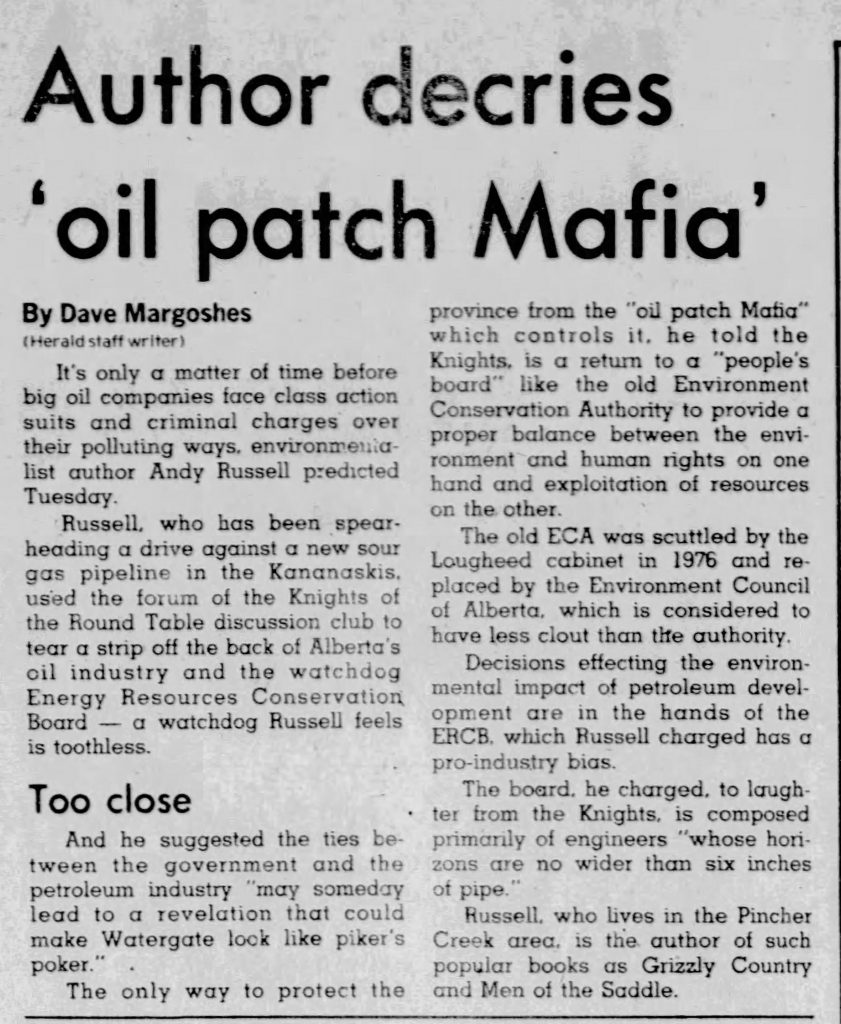
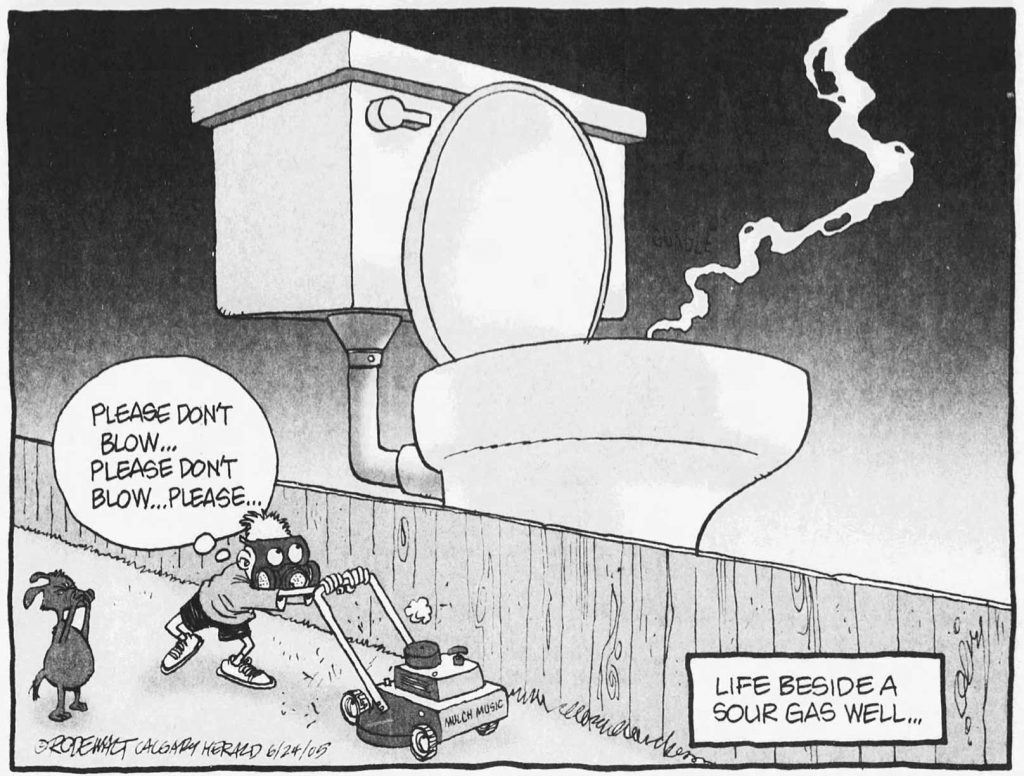
2001-2004: Enter brute force and ignorant frac experiment after decades of conventional oil and gas harms and poisoning; enter deregulation by AER whenever harmed citizens presented evidence of frac’ers breaking the law.
2005-2011: Frac impacts escalate; enter frac deregulation extraordinaire:

Enter hide and seek by health authorities:
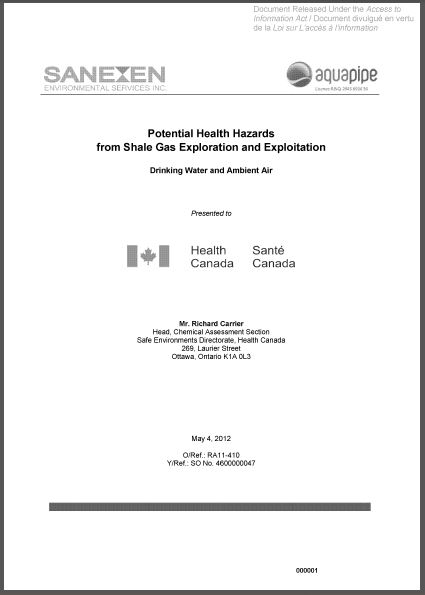
Enter wild prairie winds hammering the harmed:
2012, Frac pollution in central, heavily populated, Alberta, usually near homes, towns, farms:

When the wind blows, families breath Encana/Ovintiv’s (radioactive?) waste.

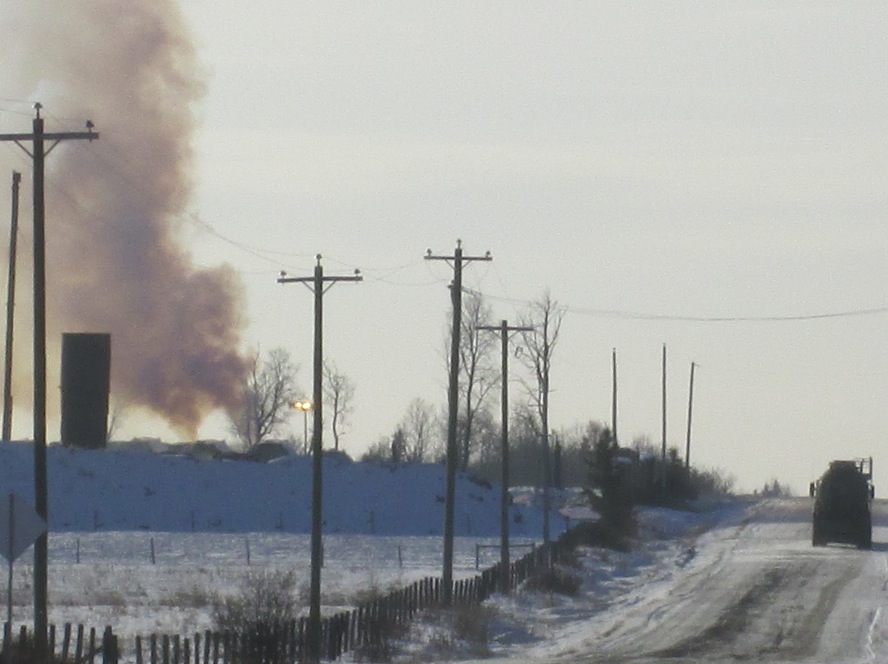
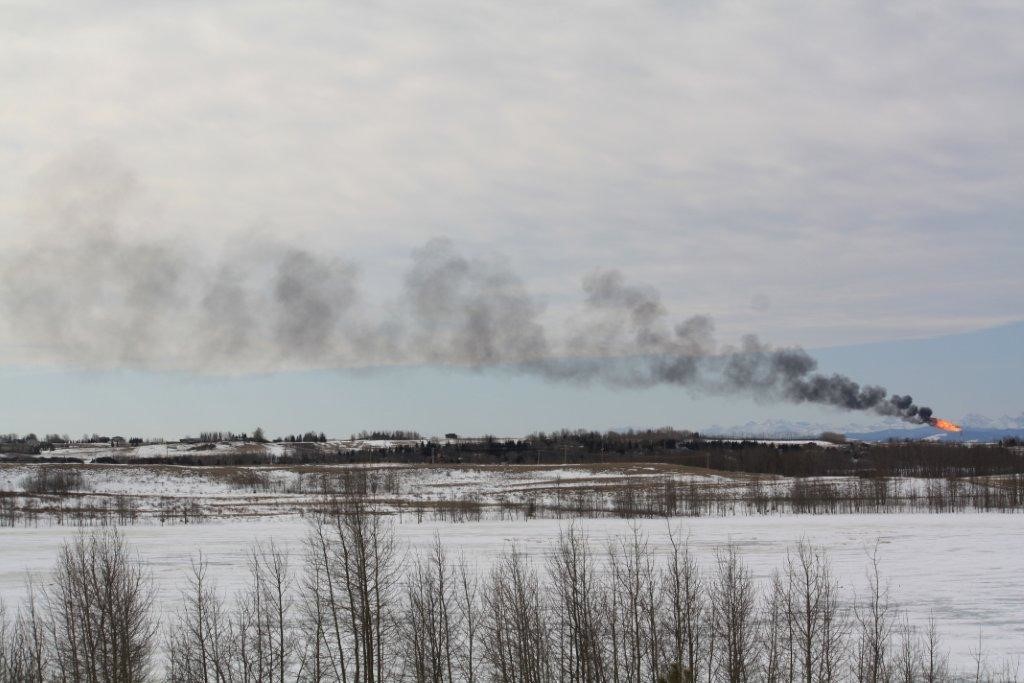
Oil patch particulate pollution blowing towards Calgary. Hold your breath, 24/7!


Frac pollution comes in many invasive forms. I hate housework. Before frac’ing, I only dusted twice a year. After frac’ing, I could dust twice a day, but I soon gave up.
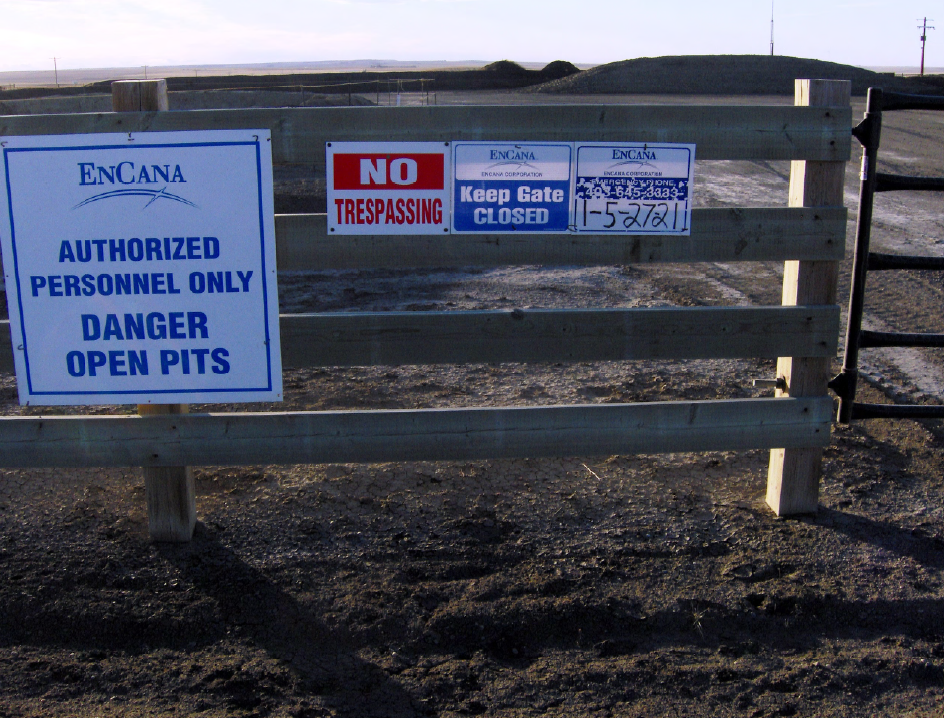
2012: Enter more mounds and pits of toxic waste: What are people breathing blowing off frac waste pits and piles? Above, Encana/Ovintiv unlined waste pits near Rosebud, AB.
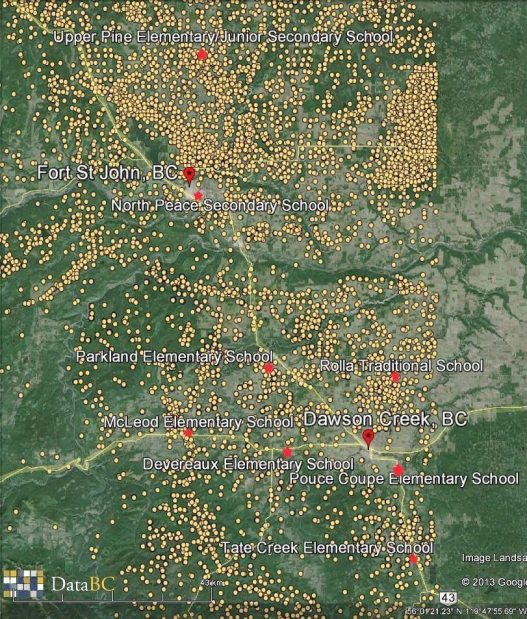
Enter toxic tank fumes:
2013: Baytex Gag Order and Can You Silence a Child


Enter more frac deregulation as frac pollution escalates!

Enter radon:
2016: Enter more and bigger pits and piles of toxic waste:

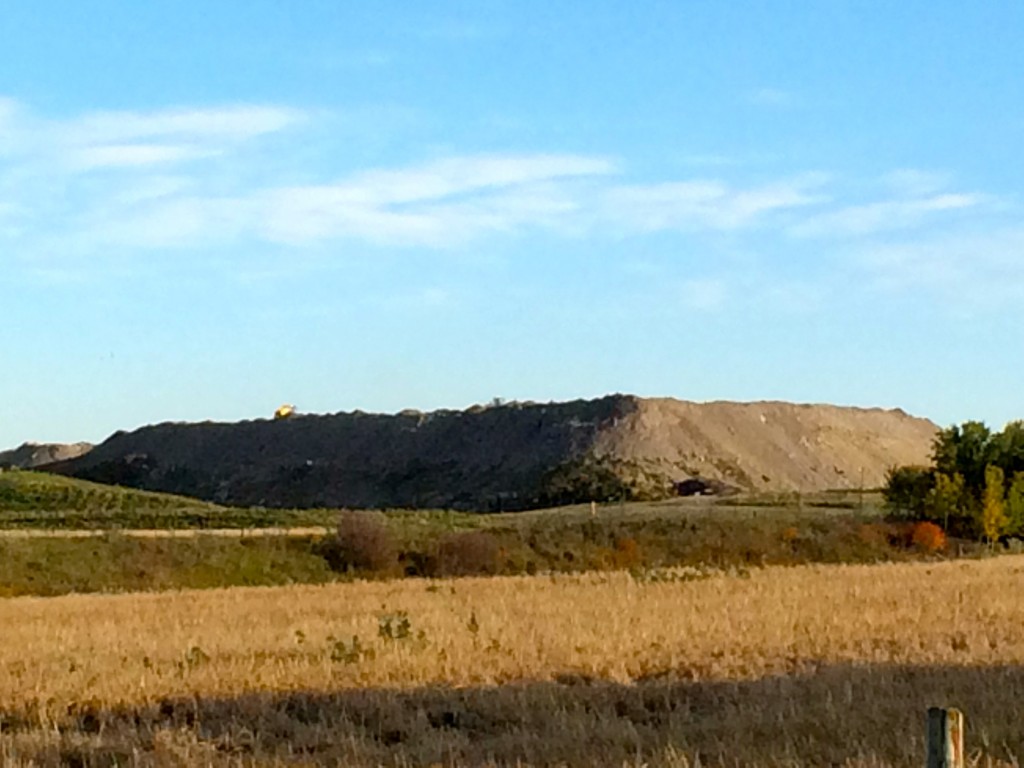
2017: What are people breathing blowing off frac waste pits and hills? What are the cumulative health harms from breathing such pollution with silica sand blowing off rail yards and frac sites, and road dust caused by frac’ers, and particulate pollution from combustion of fossil fuels at frac sites and facilities spreading in frac fields?
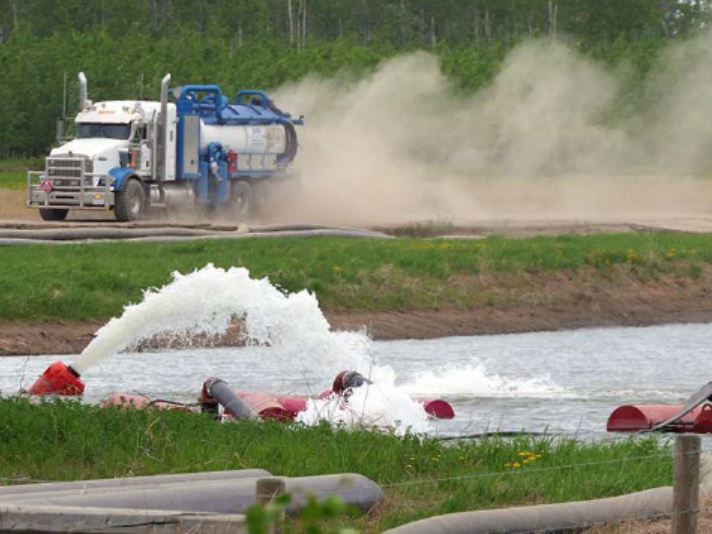
Above photo by Will Koop
Enter frac fumes and alien creatures in NEBC:
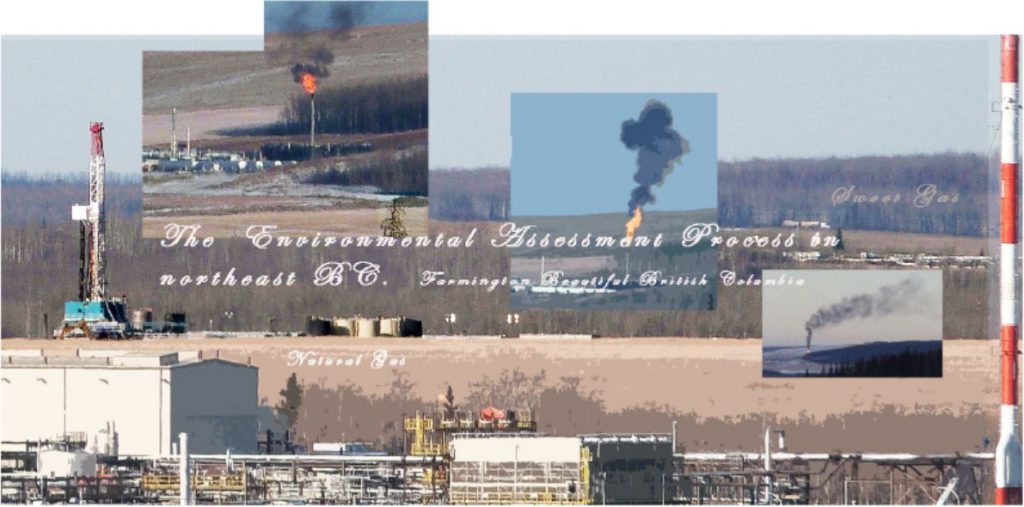

What are families breathing erupting in their frac’d communities?

Worse, what are the cumulative harms of families breathing frac particulate pollution outside, and toxic frac patch vapours rising up into their homes, businesses and barns and explosive levels of industry’s leaking gases migrating into homes?
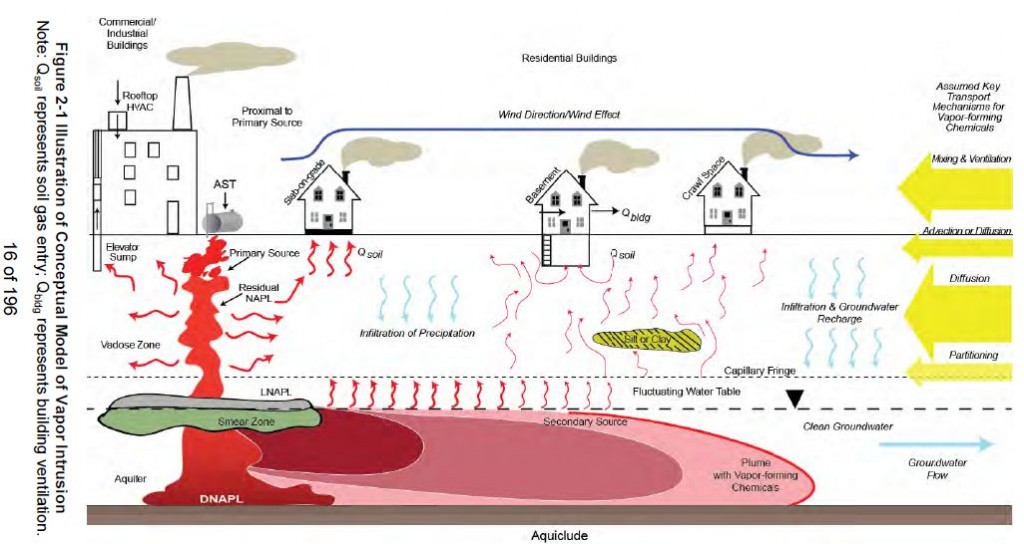
2019: Enter more and more and more frac pollution:

Sour particulate pollution thanks to Encana/Ovintiv blowing towards city of Grand Prairie, NW Alberta. Hold your breath, 24/7!
2020 Enter a pandemic:
Air pollution and COVID-19: A dangerous combination.
Study: Covid-19 outbreak risk in Italy: Role of chronic air pollution levels
Enter Australian coal companies invading caveman Alberta cumulatively polluting our wild windy prairie air, spreading coal dust across Alberta into Saskatchewan and Manitoba, with unregulated (AER is, in essence, not a regulator, it’s a fossil fuel pollution pimp) open pit / mountain top / strip mining coal mining.
MORAL OF THE ENDLESS HARMS TO ALBERTA’S PEOPLE AND ENVIRONMENT STORY? RURAL ALBERTANS NEED TO LEARN HOW TO THINK WHEN THEY VOTE, AND STOP VOTING CON IN AUTOPILOT
2021 02 08: Alberta government reinstating 1976 coal mining policy
The Alberta government is reinstating the 1976 coal mining policy it revoked last spring, which will protect areas of the Foothills and Rocky Mountains.
The four categories for where and how coal leasing, exploration and development could occur are back in place and future coal exploration approvals on sensitive Category 2 lands will be prohibited until the government does consultations on a new coal policy, Energy Minister Sonya Savage announced Monday.
The reversal comes after intense public pressure including from country singer Corb Lund and from multiple towns within the region, as well as a court challenge.
The 1976 policy, brought in by Peter Lougheed’s government, was ended by Savage in May. At the time the government said the policy was outdated and redundant.
Current exploration on Category 2 lands will continue. Four exploration projects were approved under the 1976 policy and another two after the policy was rescinded.
In January, Savage cancelled 11 coal leases issued in December and paused any future coal lease sales on Category 2 lands.
On Monday the government also said no mountaintop removal will be permitted.
2021 02 08: Comment by Kevin Van Tighem, Protect Alberta’s Rockies and Headwaters: REFER ALSO BELOW TO PIECE BY NIGEL BANKS
Well, there’s this! Basically, Minister Savage today instructed the Alberta Energy Regulator not to approve the Grassy Mountain coal mine. She specifically said she has directed AER not to permit any mountaintop removal mining (she may need to be reminded!).
Because here is an extract from the hearings into Grassy Mountain, where a lawyer for the Livingstone Landowners Group cross-examined the company’s expert witness:
Page 1007
Q· ·And then, Mr. Houston, is there any difference between open-pit mining and mountaintop removal mining?
A· ·I — I think that they’re both the same thing.
Q· ·Thank you.
A· ·Technology — the technology’s the same.· You remove the overburden and then you take out the coal.· I think the — you know, in terms of the image that you have in your mind, depends on whether you’re on the top of a mountain or digging a pit on a more or less level range.
Q· ·Okay.· And what you’re doing is you’re digging a pit on the top of the mountain.· You are removing — if you get approval, you are removing the top of Grassy Mountain; correct, Mr. Houston Page 1008 mountain, then it’s mountaintop removal mining; correct?
A· ·Yeah.· I — I’m saying that the techniques are the same, and — and there’s little distinction in — in terms of the process.
Q· ·Okay.· And this mine will be located on a mountain, and you’re going to be removing the top of that mountain; correct?
A· ·The coal — the coal deposits are up the mountain, yes, and — and so we’ll have to remove soil at the top of the mountain.
2021 02 08 Comment by Scott Webster at Protect Alberta’s Rockies and Headwaters FB Group
HOLD UP A MINUTE! …very little has changed a result of today’s reinstatement of the 1976 Coal Policy. Pausing lease sales indefinitely is cold comfort when rights to virtually every property of value has already been sold. Many of these leaseholds have been perpetually renewed for decades, roughly one-third of currently active Category 2 leaseholds were issued prior to rescission of the policy. The 1976 Coal Policy states “…leases will be granted only in areas where a reasonable likelihood exists that commercial mining operations will be permitted in the foreseeable future…”, thus making eventual commercial development of a lease a foregone conclusion. It is with this assurance that developers have conducted routine and ongoing exploratory activities on Category 2 lands for years; long before the recent rescission of the policy. Aside from Category 1, the 1976 Coal Policy does not create enduring protection for the eastern slopes, the door remains open as it was before. The fate of our eastern slopes remains under threat of extensive mining. Remain vigilant as ever. We are now brutally aware of how vulnerable these precious lands are.
2021: Nikiforuk: Critics Skeptical as Alberta Reverses Course on Open-pit Coal Mines, Five days after Kenney defended the province’s mining push, the government says it was all a big mistake.
2021 02 08: Enter a whole lot of nothin’ from the Savage UCP!~
What Are the Implications of Reinstating the 1976 Coal Development Policy? by Nigel Banks, February 9, 2021, Ablawg
PDF Version: What Are the Implications of Reinstating the 1976 Coal Development Policy?
Matters Commented On: Alberta Energy Press Release, “Alberta’s 1976 Coal Policy Reinstated” (February 8, 2021); Information Letter 2021-07 “Coal Policy Reinstatement” (8 February 2021) and attached Ministerial Order 054/2021
On February 8, 2021, Minister of Energy, Sonya Savage announced via press conference that, effective immediately, the 1976 Coal Development Policy (CDP) would be reinstated. The formal press release noted that “[t]his includes reinstating the four coal categories, which dictated where and how coal leasing, exploration and development could occur.” In addition, the release stipulated that “[a]ll future coal exploration approvals on Category 2 lands will be prohibited pending widespread consultations on a new coal policy.”
But these decisions alone will not restore the status quo as it stood prior to June 1, 2020 when the UCP government revoked the CDP without consultation. This makes the claim of reinstatement hollow – for at least two reasons.
First, since revocation of the CDP the province has issued a large number of new leases on Category 2 lands to companies that applied for leases between 1976 and revocation of the Policy on June 1, 2020. I don’t know in total how many such leases were granted but the government’s affidavit filed in the Blades judicial review application indicated that, as of early 2020, the Department had on file “506 coal lease applications (652,000 hectares) province-wide.” The province has not cancelled any of these leases. The only leases that have been cancelled were the few additional leases the Department issued as a result of a sale on December 15, 2020 (cancelled January 18, 2021).
Under section 8(1)(c) of the Mines and Minerals Act, RSA 2000, c M-17 (MMA) the Minister has the authority to cancel a lease if she
… is of the opinion that any or any further exploration for or development of the mineral to which the agreement relates within that location or part of it is not in the public interest, subject to the payment of compensation determined in accordance with the regulations for the lessee’s interest under the agreement;
The term “agreement” under the MMA includes a coal lease. The regulation providing for compensation is the Mineral Rights Compensation Regulation, Alta Reg 317/2003.
Second, in her remarks, the Minister made it clear that while she had issued a direction to the Alberta Energy Regulator (AER) not to process new application for the approval of exploration programs, this direction did not apply to exploration programs that had already been approved. Exploration programs are approved by the AER under Part 8 of the MMA and the delegation of authority to the AER under the terms of the Specified Enactments (Jurisdiction) Regulation, Alta Reg 201/2013. Readers can assess how many coal exploration programs have been approved in the intervening period by searching the AER’s website on the “publication of decision” page using the term “coal exploration.”
While section 108.4(1) of the MMA gives the Minister or the AER the authority to issue a stop work order in relation to exploration activities, it appears that this authority may only be exercised for cause (e.g. breach of a term or condition of approval). In other words, it is a narrower power than the Minister’s power under section 8 of the MMA referenced above, which can be exercised if the Minister believes that continued exploration is not in the public interest. Exploration programs may authorize a variety of exploration activities over more than one year: see Manual 008, Oil Sands and Coal Exploration Application Guide, issued in 2014 and Manual 020 Coal Development, issued in August 2020.
Minister Savage also indicated that she would be commencing consultations with respect to the development of a new provincial coal policy. While the announcement of new consultations is hardly a surprise in response to outcry from civil society and municipal governments as to the total absence of consultation back in the spring, it is less than clear what the consultations will focus on – or the legislative framework for that consultation. In practical terms, the only part of the CDP that remained operational were the land use categories. Since the CDP of 1976, Alberta has adopted a comprehensive Land-use Framework (2008) (Framework) and the associated Alberta Land Stewardship Act, SA 2009, c A-26.8 (ALSA). In other words, we now have a vehicle for making landscape-level land use planning decisions and a legislative framework for making those decisions legally binding. The problem is that the Government of Alberta has not made effective use of this regional planning process in the context of coal mining activities. The Framework contemplated seven regional planning regions, of which no fewer than five (as the map below illustrates) engage in some way with CDP’s land use categories: Upper Peace, Upper Athabasca, North Saskatchewan and South Saskatchewan. Of these five planning regions, only one has a finalized plan. This is the South Saskatchewan Regional Plan (SSRP). But as an earlier post noted, while the SSRP acknowledged the existence of the CDP and its land use categories, the SSRP effectively punted down the road any detailed assessment of whether lands within Category 2 or 3 should be available for strip mining or not.
At the same time, there is no doubt that the government could have used the SSRP to decide if and where strip mining might be a possible land use within the planning region and to prohibit it in others. There is also no doubt that it could have done so in a legally binding manner. This much is apparent from the part of the SSRP headed “Regulatory Details” (at 163). This part of the SSRP is intended to be legally binding. Of particular interest are Parts 3 and 6 of the Regulatory Details – dealing respectively with Conservation Areas and Recreation and Parks. In each case the Plan adopts highly prescriptive language along the following lines:
… a decision-maker shall not, with respect to [prescribed lands] … grant or renew any of the following statutory consents:
(a) an approval under the Coal Conservation Act;
(b) an approval under the Oil and Gas Conservation Act;
(c) an approval under the Oil Sands Conservation Act;
(d) a licence under the Pipeline Act;
(e) a disposition under the Public Lands Act. (at 169, 177)
One might also add, depending upon the circumstances, a disposition or agreement under the Mines and Minerals Act.
In short, we have a provincial land use planning framework, and we have the means to make legally binding decisions about land use. Furthermore, section 5 of the ALSA requires public consultation as part of making or amending a regional plan. It seems odd that Minister Savage made no reference to the ALSA and the Framework when promising consultations. Is this the framework within which the new coal policy consultations will take place? If not, why not?
It should be noted that there is also the matter of consultations with First Nations. Major land use decisions such as those embedded in the revocation of the CDP trigger a constitutional duty to consult with Indigenous communities whose rights may be affected. Minister Savage also needs to address this important and distinct element of the duty to consult as the government re-examines how and if coal mining is part of our shared future,
Finally, a brief word about the Grassy Mountain Coal Project. This is a proposed mine on Category 4 lands, with a decision pending on an environmental assessment by a joint (federal/provincial) review panel operating under the Canadian Environmental Assessment Act, 2012, SC 2012, c 19, s 52. As a project on Category 4 lands, revocation of the CDP will have no effect on this project. But what about Minister Savage’s comments ruling out any project that involved “mountain top removal”? Do those comments apply to the Grassy Mountain Project? While some of her remarks might support the inference of a general prohibition on “mountain top removal”, the Department’s Information Letter (which includes the new direction to the AER) makes it clear that that is not the case. The Direction (para 1(d)) quite specifically states that the confirmation required that a project not involve mountain top removal only applies to a project on Category 2 lands.
In sum, Minister Savage claims that the 1976 Policy has been reinstated, but a lot of activity has occurred between June 1, 2020 and February 8, 2021, and none of that has been rolled back. This is not reinstatement; it is reinstatement-minus what has happened since June 1.
***
Pollution denial by all authorities, especially in Alberta.
Who in Canada is looking at the significant cumulative harms to public health, families and communities neighbouring fossil fuel projects, notably in frac fields?
